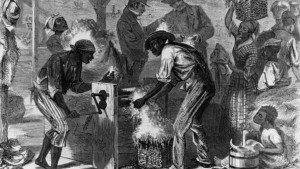What Was the Second Middle Passage?
Thanks to the Trans-Atlantic Slave Trade Database, edited by David Eltis and David Richardson, we know that about 388,000 Africans were transported directly to the United States over the course of the slave trade, which ended officially in 1808. This brutally cruel and disruptive phase of the trade, as all American schoolchildren should be taught, is known as “the Middle Passage.” But what is often left out of many survey courses is the second Middle Passage, and that dark chapter in American history involved far more black people than were taken from Africa to the United States. It was also uniquely cruel and brutally destructive. And it unfolded during the era when cotton was “king.”
That second forced migration was known as the domestic, or internal, slave trade: “In the seven decades between the ratification of the Constitution [in 1787] and the Civil War [1861],” the historian Walter Johnson tells us in his book Soul by Soul: Life Inside the Antebellum Slave Market, “approximately one million enslaved people were relocated from the upper South to the lower South … two thirds of these through … the domestic slave trade.” In other words, two and a half times more African Americans were directly affected by the second Middle Passage than the first one.
When we think of the image of slaves being sold “down the river” on auction blocks — mothers separated from children, husbands from wives — it was during this period that these scenes became increasingly common. The enslaved were sometimes marched hundreds of miles to their destinations, on foot and in chains. Indeed, the years between 1830 and 1860 were the worst in the history of African-American enslavement.
Why? Because of the unprecedented growth of the cotton industry. Until Eli Whitney invented the cotton gin and had it patented in 1794, cotton harvesting was extremely labor-intensive. The cotton gin is deceptively simple: It just separates cotton fibers, or “lint,” from the seeds. Before the cotton gin, one person could clean five or six pounds of cotton a day; using the cotton gin, one person could clean a thousand pounds of cotton a day! The effects were immediate and dramatic: As the historian Ronald Bailey explains in an article for Agricultural History, in 1790, the United States produced 1.5 million pounds of cotton; in 1800, it produced 35 million pounds of cotton! By 1830, that figure had grown to 331 million, and by 1860, on the eve of the Civil War, cotton production had grown to 2,275 million pounds.
The more money the planters made from cotton, the more cotton they wanted to grow. The more cotton the planters wanted to grow, the more slaves they needed to grow the cotton. The world’s desire for cotton — and the Southern planters’ and Northern industrialists’ desire for profits — seemed insatiable.
Meanwhile, since the slave trade from Africa was ended in 1808, slaves in the Upper South had become extremely valuable commodities. Their owners, whose tobacco plantations were no longer, say, sufficiently profitable, sold them south, in droves. As Ira Berlin concludes in The Making of African America: The Four Great Migrations, “the internal slave trade became the largest enterprise in the South outside of the plantation itself, and probably the most advanced in its employment of modern transportation, finance and publicity.”
Most of us are familiar with the dreadful Trail of Tears, which in 1838 removed the last of the Chickasaw, the Cherokee, the Creek, the Choctaw and the Seminoles from the region of the South known as the “black belt,” resettling them to “Indian Territory,” which became the state of Oklahoma in 1907. Ever wonder why this was necessary? In a word, cotton. These Native American people were living on what was perhaps the richest cotton soil in the world. And their removal, following the Louisiana Purchase, created a scramble to settle their lands and raise cotton, leading to one of the greatest periods in economic expansion and profitability in American history.
The number of slaves needed in the new states of Alabama, Mississippi and Louisiana, where cotton reigned, increased by an average of 27.5 percent each decade, demanding that entire families be relocated from plantations in the East and Upper South. As Steven Deyle points out, “Southern slave prices more than tripled,” rising from $500 in New Orleans in 1800, to $1,800 by 1860 (the equivalent of $30,000 in 2005).
Of the 3.2 million slaves working in the 15 slave states in 1850, 1.8 million worked in cotton. No wonder the dominant motto of the era was “Cotton is King!” Cotton produced by slave labor was so profitable that it would take a costly Civil War, and the loss of more than 600,000 lives, to end it.
Fifty of the 100 Amazing Facts will be published on The African Americans: Many Rivers to Cross website. Read all 100 Facts on The Root.
Find educational resources related to this program - and access to thousands of curriculum-targeted digital resources for the classroom at PBS LearningMedia.
Visit PBS Learning Media







